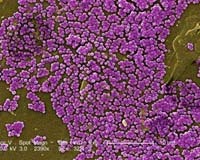Scientists studying the genetic make-up of these bugs, which are resistant to almost all antibiotics, say they are nearly identical clones that have emerged from a single bacterial strain, which they have dubbed USA300.
"The USA300 group of strains appears to have extraordinary transmissibility and fitness," said Frank DeLeo, a researcher with the National Institute of Allergy and Infectious Diseases (NIAID) in Hamilton, Montana.

|
| ©Unknown |
"We anticipate that new USA300 derivatives will emerge within the next several years and that these strains will have a wide range of disease-causing potential."
Most drug-resistant staph infections cause soft-tissue infections such as boils that are readily treatable, but a skin infection can become a deadly pneumonia or blood or bone infection in a matter of days if the patient doesn't get the right drugs.
What's particularly worrying to health authorities is that the MRSA infections, (methicillin-resistant Staphylococcus aureus) have spread beyond their traditional hospital setting, seeding an epidemic in the wider community.
The NIAID scientists studied the DNA of 10 patient samples of the USA300 bacterium taken from individuals treated at different US locations between 2002 and 2005. They compared the genetic sequences of the bugs to each other and to USA300 strains used in earlier studies.
The genomes of eight of the 10 patient samples were virtually identical, indicating they came from a common strain. The remaining two bacteria were related to the other eight, but more distantly.
The study appears in the Proceedings of the National Academy of Sciences.



Reader Comments
to our Newsletter